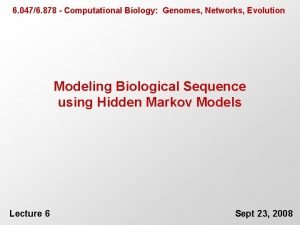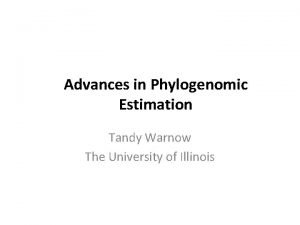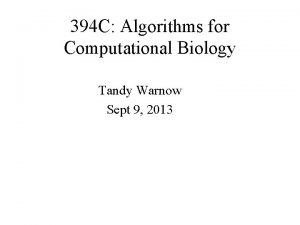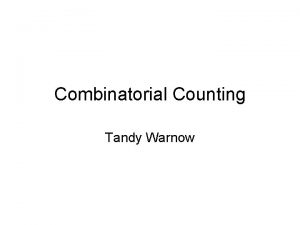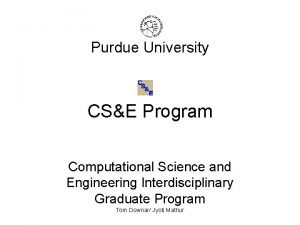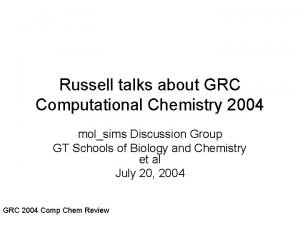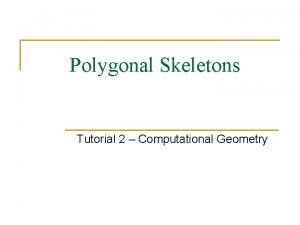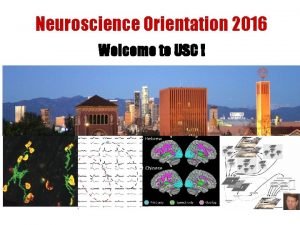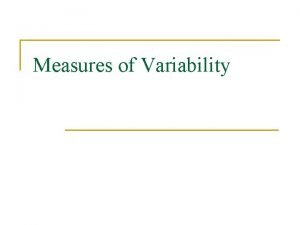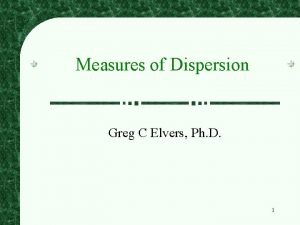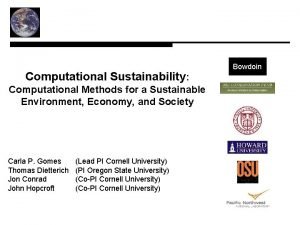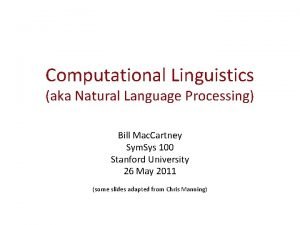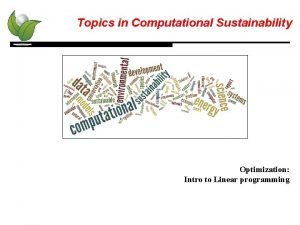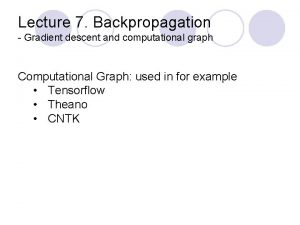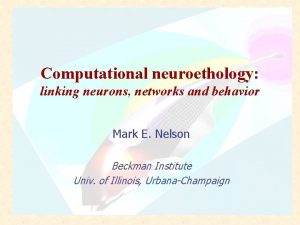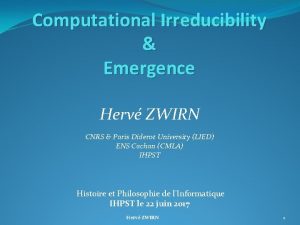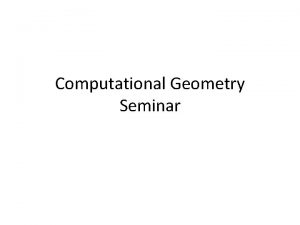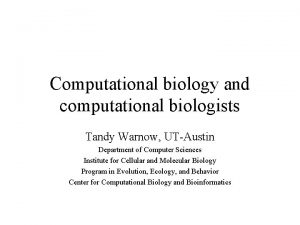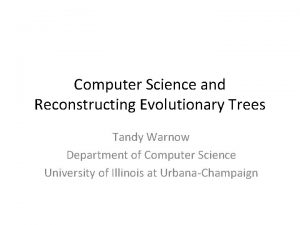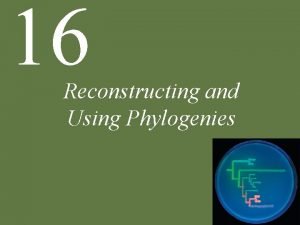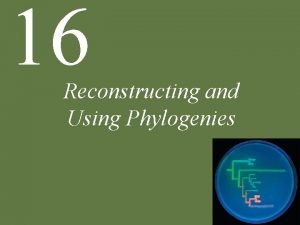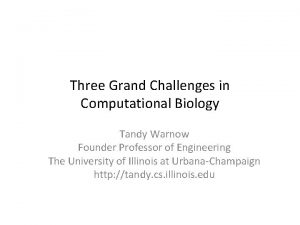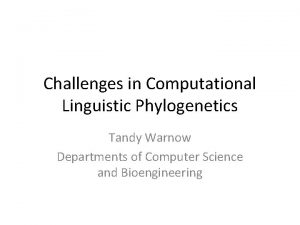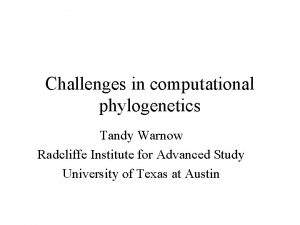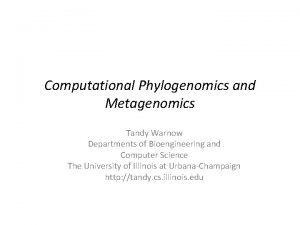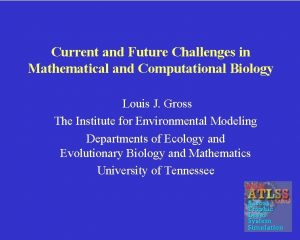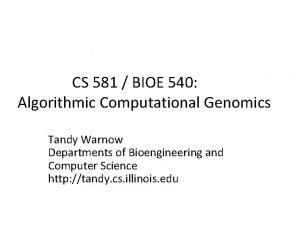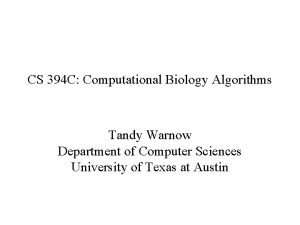Mathematical and Computational Challenges in Reconstructing Evolution Tandy

























































- Slides: 57

Mathematical and Computational Challenges in Reconstructing Evolution Tandy Warnow The University of Illinois

Phylogeny (evolutionary tree) Orangutan From the Tree of the Life Website, University of Arizona Gorilla Chimpanzee Human

• “Nothing in biology makes sense except in the light of evolution” – Theodosius Dobzhansky, 1973 essay in the American Biology Teacher, vol. 35, pp 125 -129 • “…. . . nothing in evolution makes sense except in the light of phylogeny. . . ” – Society of Systematic Biologists, http: //systbio. org/teachevolution. html

This Talk • Models of evolution, identifiability, statistical consistency • Genome-scale phylogeny: – Incomplete lineage sorting and species tree estimation under the Multi-Species Coalescent model (MSC) – ASTRAL: non-parametric accurate and statistically consistent species tree estimation under the MSC – NJMerge: scaling species tree methods to large datasets – Statistical consistency when number of sites per locus is bounded • Open questions • Future directions

DNA Sequence Evolution (Idealized) -3 mil yrs AAGACTT AAGGCCT AGGGCAT TAGCCCA -2 mil yrs TGGACTT TAGACTT AGCACAA AGCGCTT -1 mil yrs today

Markov Models of Sequence Evolution The different sites are assumed to evolve i. i. d. down the model tree (with rates that are drawn from a gamma distribution).

Markov Models of Sequence Evolution The different sites are assumed to evolve i. i. d. down the model tree (with rates that are drawn from a gamma distribution). Simplest site evolution model (Jukes-Cantor, 1969): • The model tree T is binary and has substitution probabilities p(e) on each edge e, with 0<p(e)<3/4. • The state at the root is randomly drawn from {A, C, T, G} (nucleotides) • If a site (position) changes on an edge, it changes with equal probability to each of the remaining states. • The evolutionary process is Markovian. More complex models (such as the General Markov model) are also considered, often with little change to theory.

Statistical Consistency error Data

Questions • Is the model tree identifiable? • Which estimation methods are statistically consistent under this model? • How much data does the method need to estimate the model tree correctly (with high probability)?

Answers? • We know a lot about which site evolution models are identifiable, and which methods are statistically consistent. • We know a little bit about the sequence length requirements for standard methods. Take home message: need to limit (or not allow) heterogeneity to get identifiability!

Genome-scale data? error Data

Phylogeny + genomics = genome-scale phylogeny estimation.

Incomplete Lineage Sorting (ILS) is a dominant cause of gene tree heterogeneity

Gene trees inside the species tree (Coalescent Process) Past Present Courtesy James Degnan Gorilla and Orangutan are not siblings in the species tree, but they are in the gene tree.

Gene trees inside the species tree (Coalescent Process) Past Deep coalescence = INCOMPLETE LINEAGE SORTING (ILS): gene tree can be different from the species tree Present Courtesy James Degnan Gorilla and Orangutan are not siblings in the species tree, but they are in the gene tree.

1 KP: Thousand Transcriptome Project G. Ka-Shu Wong J. Leebens-Mack U Alberta U Georgia N. Wickett Northwestern N. Matasci i. Plant T. Warnow, UT-Austin S. Mirarab, UT-Austin N. Nguyen UT-Austin 103 plant transcriptomes, 400 -800 single copy “genes” Next phase will be much bigger Wickett, Mirarab et al. , PNAS 2014 Major Challenge: • Massive gene tree heterogeneity consistent with ILS

Major challenge: • Massive gene tree heterogeneity consistent with ILS.


Statistically consistent methods • Coalescent-based summary methods: Estimate gene trees, and then combine together (ASTRAL, ASTRID, MP-EST, NJst, and others) • Co-estimation methods: Co-estimate gene trees and species trees (TOO EXPENSIVE) • Site-based methods: estimate the species tree from the concatenated alignment, and do not estimate gene trees (NOT WELL STUDIED)

Species Main competing approaches gene 1 gene 2. . . gene k Concatenation Analyze separately . . . Summary Method

What about summary methods? . . .

What about summary methods? . . . Techniques: Most frequent gene tree? Consensus of gene trees? Other?

Species tree estimation from unrooted gene trees Theorem (Allman et al. ): Under the multi-species coalescent model, for any four taxa A, B, C, and D, the most probable unrooted gene tree on {A, B, C, D} is identical to the unrooted species tree induced on {A, B, C, D}.

Species tree estimation from unrooted gene trees Theorem (Allman et al. ): Under the multi-species coalescent model, for any four taxa A, B, C, and D, the most probable unrooted gene tree on {A, B, C, D} is identical to the unrooted species tree induced on {A, B, C, D}. Proof: For every four species, select most frequently observed tree as the species tree. Then combine quartet trees!

Species tree estimation from unrooted gene trees Theorem (Allman et al. ): Under the multi-species coalescent model, for any four taxa A, B, C, and D, the most probable unrooted gene tree on {A, B, C, D} is identical to the unrooted species tree induced on {A, B, C, D}. Proof: For every four species, select most frequently observed tree as the species tree. Then combine quartet trees!


Constrained Maximum Quartet Support Tree • Input: Set T = {t 1, t 2, …, tk} of unrooted gene trees, with each tree on set S with n species, and set X of allowed bipartitions • Output: Unrooted tree T on leafset S, maximizing the total quartet tree similarity to T, subject to T drawing its bipartitions from X. Theorems (Mirarab et al. , 2014): • If X contains the bipartitions from the input gene trees (and perhaps others), then an exact solution to this problem is statistically consistent under the MSC. • The constrained MQST problem can be solved in O(|X|2 nk) time. (We use dynamic programming, and build the unrooted tree from the bottom-up, based on “allowed clades” – halves of the allowed bipartitions. ) Conjecture: MQST is NP-hard

Constrained Maximum Quartet Support Tree • Input: Set T = {t 1, t 2, …, tk} of unrooted gene trees, with each tree on set S with n species, and set X of allowed bipartitions • Output: Unrooted tree T on leafset S, maximizing the total quartet tree similarity to T, subject to T drawing its bipartitions from X. Theorems (Mirarab et al. , 2014): • If X contains the bipartitions from the input gene trees (and perhaps others), then an exact solution to this problem is statistically consistent under the MSC. • The constrained MQST problem can be solved in O(|X|2 nk) time. (We use dynamic programming, and build the unrooted tree from the bottom-up, based on “allowed clades” – halves of the allowed bipartitions. ) Conjecture: MQST is NP-hard

Constrained Maximum Quartet Support Tree • Input: Set T = {t 1, t 2, …, tk} of unrooted gene trees, with each tree on set S with n species, and set X of allowed bipartitions • Output: Unrooted tree T on leafset S, maximizing the total quartet tree similarity to T, subject to T drawing its bipartitions from X. Theorems (Mirarab et al. , 2014): • If X contains the bipartitions from the input gene trees (and perhaps others), then an exact solution to this problem is statistically consistent under the MSC. • The constrained MQST problem can be solved in O(|X|2 nk) time. (We use dynamic programming, and build the unrooted tree from the bottom-up, based on “allowed clades” – halves of the allowed bipartitions. )

Used Sim. Phy, Mallo and Posada, 2015



Accuracy in the presence of HGT + ILS Davidson et al. , RECOMB-CG, BMC Genomics 2015

Impact of Gene Tree Estimation Error (from Molloy and Warnow 2017) Error is fraction of bipartitions that are not recovered Summary Methods Site-based Method

Impact of Gene Tree Estimation Error (from Molloy and Warnow 2017) Note: Summary methods better than CA-ML for low GTEE, then worse! Error is fraction of bipartitions that are not recovered Summary Methods Site-based Method

Summary (so far) • ASTRAL has high accuracy, is relatively robust to gene tree estimation error, missing data, and HGT. • ASTRID is also good, but not generally quite as accurate as ASTRAL. • Concatenation using ML: unpartitioned CA-ML not statistically consistent under the MSC but can be more accurate than even the best summary methods when ILS is low enough or gene tree estimation error is high enough • Site-based methods (e. g. , SVDquartets): promising but not as good on simulated data as CA-ML, and not as good as summary methods except under very high gene tree estimation error


But ASTRAL can fail to return a tree within 24 hrs on some very large datasets with high ILS

Scalability to large datasets • All the methods described here (except distance-based methods such as ASTRID, NJst) have computational challenges on datasets with large numbers of species: – SVDquartets: best accuracy obtained if computing all quartet trees – ASTRAL: can fail on some datasets with many species and genes (constraint space too big) – CA-ML: no current method scales to large numbers of species and genes

NJMerge • General technique for scaling phylogeny estimation methods to large numbers of species • Approach: – Divide species set into disjoint subsets – Construct species tree (constraint tree) on each subset – Merge together using a modification of Neighbor Joining, obeying constraint trees, using pairwise distances between species from the “internode distance matrix” (used in ASTRID and NJst) – Note: can sometimes fail to return a tree (0. 2% of cases in our experiments) • Molloy and Warnow, RECOMB-CG 2018 (to appear)

NJMerge + SVDquartets vs. SVDquartets: Better accuracy and can analyze larger datasets!

NJMerge + ASTRAL vs. ASTRAL: Comparable accuracy and can analyze larger datasets

NJMerge + RAx. ML vs. RAx. ML: Better accuracy and faster!

NJMerge summary • NJMerge+ASTRAL: generally as accurate and faster on large datasets than ASTRAL • NJMerge+SVDquartets: more accurate and much faster, greater scalability than SVDquartets • NJMerge+CA-ML: more accurate and much faster, greater scalability than CA-ML Only limitation: NJMerge can sometimes fail to return a tree, but this only occurred in 0. 2% of the datasets we examined in our experiments. (Other methods also fail to return a tree due to time constraints. )

Which type of method is best? • What is the meaning of “best”? – Statistically consistent under the MSC? – Good accuracy on simulated data? – Good accuracy on biological data?

Genome-scale data? error Data = sites? genes?

Statistical consistency for summary methods error Data = true gene trees!

Impact of Gene Tree Estimation Error (from Molloy and Warnow 2017) Note: Summary methods better than CA-ML for low GTEE, then worse! Error is fraction of bipartitions that are not recovered Summary Methods Site-based Method

Gene tree estimation error: key issue in the debate • Multiple studies show that summary methods can be less accurate than concatenation in the presence of high gene tree estimation error. • Genome-scale data includes a range of markers, not all of which have substantial signal. Furthermore, removing sites due to model violations reduces signal. • Some researchers also argue that “gene trees” should be based on very short alignments, to avoid intra-locus recombination.

What about performance on bounded number of sites? • Question #1: Do any summary methods converge to the species tree as the number of loci increase, but where each locus has only a constant number of sites? • Answer #1: Roch & Warnow, Syst Biol, March 2015: – Strict molecular clock: Yes for some new methods, even for a single site per locus – No clock: Unknown for all methods, including MP -EST, ASTRAL, etc. S. Roch and T. Warnow. "On the robustness to gene tree estimation error (or lack thereof) of coalescent-based species tree methods", Systematic Biology, 64(4): 663 -676, 2015

What about performance on bounded number of sites? • Question #1: Do any summary methods converge to the species tree as the number of loci increase, but where each locus has only a constant number of sites? • Answer #2: Roch, Nute, & Warnow, accepted to Syst Biol. • No! Summary methods are not only not consistent, they can be positively misleading! (Felsenstein Zone) S. Roch, M. Nute, and T. Warnow. "Long-branch attraction in species tree estimation: inconsistency of partitioned likelihood and topology-based summary methods. ” ar. Xiv: 1803. 02800

What about performance on bounded number of sites? • Question #2: What about concatenation using maximum likelihood? • Answer: Roch, Nute, & Warnow, accepted to Syst Biol. • Not if fully partitioned! Concatenation using maximum likelihood, if fully partitioned is also not consistent and can be positively misleading (even if there is NO ILS)! (Felsenstein Zone) S. Roch, M. Nute, and T. Warnow. "Long-branch attraction in species tree estimation: inconsistency of partitioned likelihood and topology-based summary methods. ” ar. Xiv: 1803. 02800

Statistically consistent methods • Coalescent-based summary methods: Estimate gene trees, and then combine together (ASTRAL, ASTRID, MP-EST, NJst, and others) • Co-estimation methods: Co-estimate gene trees and species trees (TOO EXPENSIVE) • Site-based methods: estimate the species tree from the concatenated alignment, and do not estimate gene trees (NOT WELL STUDIED)

Statistically consistent methods (? ? ) • Coalescent-based summary methods: Estimate gene trees, and then combine together (ASTRAL, ASTRID, MP-EST, NJst, and others) • Co-estimation methods: Co-estimate gene trees and species trees (TOO EXPENSIVE) • Site-based methods: estimate the species tree from the concatenated alignment, and do not estimate gene trees (NOT WELL STUDIED)

Future Directions • Theory: Determine which species tree estimation methods are statistically consistent when the number of sites per locus is bounded, and heterogeneity between loci is not constrained • Practice: Understand why concatenation performs well, and develop better coalescentbased methods

• • • NP-hard optimization problems and large datasets Statistical estimation under stochastic models of evolution Probabilistic analysis of algorithms Graph-theoretic divide-and-conquer Chordal graph theory Combinatorial optimization

Acknowledgments Roch and Warnow, Systematic Biology 2014 Mirarab and Warnow, Bioinformatics 2015 Molloy and Warnow, Systematic Biology 2017 Molloy and Warnow, RECOMB-CG 2018 Roch, Nute, and Warnow, ar. Xiv: 1803. 02800 (accepted to Systematic Biology) Papers available at http: //tandy. cs. illinois. edu/papers. html Funding: NSF, Grainger Foundation, and HHMI (to SM).
 Chapter 12 section 2 reconstructing society
Chapter 12 section 2 reconstructing society Chapter 12 section 2 reconstructing society
Chapter 12 section 2 reconstructing society Computational biology: genomes, networks, evolution
Computational biology: genomes, networks, evolution Tandy warnow
Tandy warnow Fineboosting
Fineboosting Tandy warnow
Tandy warnow Tandy warnow
Tandy warnow Tandy warnow
Tandy warnow Tandy warnow
Tandy warnow Tandy warnow
Tandy warnow Tandy trower
Tandy trower Hoaloha robotics
Hoaloha robotics Tandy warnow
Tandy warnow Mathematical economics vs non mathematical economics
Mathematical economics vs non mathematical economics Challenges for more able pupils
Challenges for more able pupils Mathematical challenges for able pupils
Mathematical challenges for able pupils Mathematical challenges for able pupils
Mathematical challenges for able pupils Shape puzzle
Shape puzzle Mathematical challenges for able pupils ks1
Mathematical challenges for able pupils ks1 Mathematical challenges for able pupils
Mathematical challenges for able pupils Mathematical challenges for able pupils
Mathematical challenges for able pupils Mathematical challenges for able pupils
Mathematical challenges for able pupils Mathematical challenges for more able pupils
Mathematical challenges for more able pupils Mathematical challenges for able pupils
Mathematical challenges for able pupils Mathematical challenges for able pupils
Mathematical challenges for able pupils Computational thinking algorithms and programming
Computational thinking algorithms and programming Using mathematics and computational thinking
Using mathematics and computational thinking Cs 514 purdue
Cs 514 purdue Computational engineering and physical modeling
Computational engineering and physical modeling Characteristics of computational thinking
Characteristics of computational thinking Grc computational chemistry
Grc computational chemistry Computational geometry tutorial
Computational geometry tutorial Computational neuroscience usc
Computational neuroscience usc Standard deviation computational formula
Standard deviation computational formula Standard deviation computational formula
Standard deviation computational formula Computational math
Computational math Abstraction computer science gcse
Abstraction computer science gcse Computational sustainability cornell
Computational sustainability cornell Chomsky computational linguistics
Chomsky computational linguistics Xkcd computational linguistics
Xkcd computational linguistics Cmu computational biology
Cmu computational biology Dsp computational building blocks
Dsp computational building blocks Amortized time complexity
Amortized time complexity Computational sustainability subjects
Computational sustainability subjects The computational complexity of linear optics
The computational complexity of linear optics Leerlijn computational thinking
Leerlijn computational thinking Computational demand
Computational demand Computational graph
Computational graph Computational graph
Computational graph Computational thinking jeannette wing
Computational thinking jeannette wing Computational radiology
Computational radiology Computational photography uiuc
Computational photography uiuc Relly brandman
Relly brandman Basic computational models in computer architecture
Basic computational models in computer architecture Computational methods in plasma physics
Computational methods in plasma physics Computational irreducibility
Computational irreducibility Computational geometry
Computational geometry Computational chemistry branches
Computational chemistry branches


